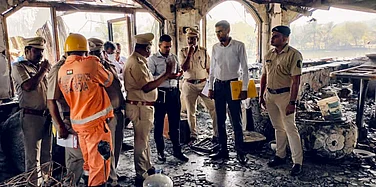In February this year, Padma Dechan, a resident of Chhaling village in Miyar Valley fell seriously ill. The Valley falls in the picturesque Lahaul-Spiti district in Himachal Pradesh. The remote region is also known as “cold desert” and it is virtually cut off in the winter due to heavy snowfall. So, when Dencha needed emergency medical attention, the local MLA had to intervene. He got in touch with the Chief Minister of Himachal Pradesh, Sukhvinder Singh Sukhu, and finally, Dechan was airlifted to a government hospital in Kullu on February 4.
Lahaul-Spiti is a fascinating land of Gompas and monasteries and is a popular tourist destination. However, due to its tough terrain and difficult climatic conditions, living here is not easy. Almost half of the year, the area remains under snow and temperature dips down to minus 28-30 degree Celsius making life difficult.
The only connectivity to the world is through requisitioned helicopter service, particularly at the time of medical emergencies to airlift critical patients, as happened in the case of Dechan.
Due to such difficult climatic conditions, people have been migrating to neighbouring districts and plains. This has led to the district being sparsely populated, which is affecting the socio-economic fabric of the region. Some of the villages like Hikkim, Chichham, Langza, Demul, Komic and Kibber have an extremely low density of population, often lacking basic amenities of living.
As per the 2011 census, the remote tribal district witnessed a negative decadal population growth rate of -5.0 per cent against the state’s overall decadal growth of 12.8 per cent. Kinnaur, another high-altitude tribal district, also reflects lower population growth of 7.6 per cent. The trend appears to have not changed.
The 2011 census says the density of Lahaul-Spiti district was lowest at 2 people per sq km and at 31,528 in an area of 13,841 sq km.
Interestingly, Lahaul-Spiti shares an international border with China. India recently overtook China as the world’s most populous country. In this context, it is important to focus on sparsely populated areas like Lahaul-Spiti and the socio-economic impact of such a low population on people and the region.
Many attribute reasons for the negative growth trend to the migration of a number of families from the region to the adjoining district of Kullu to escape harsh weather conditions and for a comfortable living. Even with the lack of basic amenities like drinking water, healthcare and higher education, most villages on the Indo-Tibet border are facing a consistent exodus, primarily of the younger generation who move out for jobs.
Many local families have bought lands in Kullu-Manali or Dharamshala and are living there. Only one or two family members have stayed back to grow cash crops/fruits. Others pick up jobs or have set up businesses elsewhere in Himachal Pradesh.
Balbir Tegta, a retired IAS officer, who was the director of Census, 2011, says: “Education and better living conditions are dominant factors behind migration but these are not the only reasons for the negative decadal population growth. People opting for smaller families and having one-two children is also a significant reason.”
In Spiti, another notable reason for the low negative growth is the custom of sending young children to monasteries. Boys become monks (lama) and girls become nuns (Chomo). Some of the girls from the region volumetrically choose to become nuns leaving their families behind. They serve at nunneries in Spiti and the neighbouring areas. Low fertility rate is also a reason behind declining growth in Lahual-Spiti and Kinnaur as some villages still follow the traditional practice of polyandry. Though in decline, it has not completely vanished.
Tenzin Norbu, Spiti’s Block Medical officer, says: “People are highly conscious about small family norms. It’s because of their social approach towards the issue of the population to keep the family limited to one or two children. We have also been aggressively promoting this concept. Spiti is a good model of voluntary adoption of small family concepts.”
He admits that there was a time when people in Spiti or Lahaul used to have more than two children. Even then, they used to send at least one child to monasteries.
In her short film, ‘No Women’s Land’ based on women of Kinnaur and Lahaul-Spiti, young filmmaker Dev Kenya Thakur has highlighted how the custom of sending one child to monastery/nunnery has stopped the fragmentation of family lands. When a son becomes a lama (monk), he loses any right over ancestral property. This also has an impact on the population rise.
As per the 2011 Census, the total population of Himachal Pradesh is 68.65 lakh. The state population was 0.57 per cent of India’s population in 2011. The total area of the state is 55,673 sq km. Thus, the population density of the state is 123 per sq km, which is lower than the national average of 382 per sq km.
Vinod Kumar Rana, the state’s Economic and Statistics advisor, terms the projected population growth in the case of Himachal Pradesh as worrisome, not alone in the case of extremely low-density districts like Chamba, Lahual-Spiti, Kinnaur and Kullu but even for the rest of the districts.
Unemployment is causing a serious imbalance in the demography of some mountain areas. People migrating from low-density villages close to the international border is something that is not in the best interest of the state. Thus, some employment programmes need to be initiated and basic infrastructure facilities like roads, health facilities, drinking water, telecom/mobile/internet and electricity should be provided even in the remotest areas.
There have been some positive changes. There was a time when farm activity was limited to growing agricultural produce like barley for self-use, but now people are growing a variety of cash crops like seed potatoes, peas, and apples. Transportation is still an issue. Road connectivity has improved and so has the electricity supply, but there is still a scarcity of drinking water scarcity in remote tribal areas.
“The construction of Rohtang Tunnel in 2020 has benefitted the people of Lahaul-Spiti and has ended their isolation from the rest of the country during winters. This has helped in better mobility, transportation and economic activities, tourism in particular,” says Rana.
Spiti Valley is connected by Kunzum Pass (15060 ft high) which gets disconnected in winter. Incidences of avalanches disrupt road communication. There is now a move to build a tunnel from Kinnaur to provide alternate connectivity to Spiti. It could help in arresting population migration.
On April 15, for the first time in 75 years, Kaza village in Spiti was picked as a destination to celebrate Himachal Day. While speaking at the function, Chief Minister Sukhu said: “The living conditions in Lahaul-Spiti are bad. Life is tough and winters are extremely harsh. The condition of women, in particular, is pitiable. I was surprised to note that during the past three decades, despite huge budget and funds pumped into the region in the name of development, people in Spiti still have to struggle for water.”
He later sent a team led by Ramsubhag Singh, former Chief Secretary and his current advisor, to study the problems of Spiti and submit a report suggesting solutions. Sukhu hopes that an improvement in infrastructural conditions will also see a change in population trends as well.
Recently, the central government has also initiated the “Vibrant Village” programme to focus on livelihood activities and tourism-oriented projects. It will be launched in around 198 villages that are closest to the China border on priority. “This will help in a big way in integrating the border villages and checking the migration of tribal people,” feels former Kinnaur MLA Tejwant Singh Negi.


























